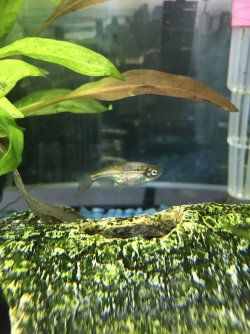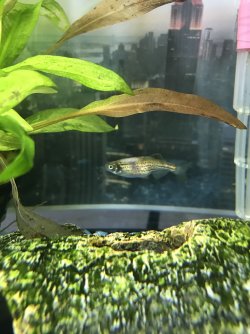I can't really tell from the pics, can you try to get a closer picture of the fish. Set the camera's resolution to about 2MB and use the flash. Have the room and tank lights on and open the curtains if it's daytime. This will get more light into the room and the image should be sharper.
---------------------
Zebra and Leopard danios only live for a few years and higher temperatures cause them to age faster. They do well at a temperature around 18-22C but will tolerate temps between 16-30C.
The fish in the picture is female and is carrying eggs. It might also have an internal problem but I need a better picture to tell. If you look at her body, see if any of her scales are sticking out from the body around the belly area. Monitor her poop and see if it is white and stringy or looks normal, it should be dark and not hang about for very long.
---------------------
Have you added anything new to the tank in the last 2 weeks (fish, plants, snails, shrimp, etc)?
The patch on the back could be bacterial or protozoan. Fungus is normally white and fluffy and occurs in areas that have been damaged by poor water quality or actual physical damage.
Depending on what else is in the tank will determine what you treat the fish with. A broad spectrum fish medication that treats bacteria, fungus and protozoans will probably work, but you should try doing a big 75% water change and gravel clean the substrate first and see how the fish looks after 12-24 hours. Clean the filter too if it hasn't been done in the last 2 weeks. If there is no improvement after 24 hours then treat.
---------------------
To work out the volume of water in the tank:
measure length x width x height in cm.
divide by 1000.
= volume in litres.
When you measure the height, measure from the top of the substrate to the top of the water level.
There is a calculator/ converter in the "How To Tips" at the top of this page that will let you convert litres to gallons if you need it.
Remove carbon from the filter before treating or it will absorb the medication and stop it working.
Wipe the inside of the glass down, do a 75% water change and complete gravel clean. And clean the filter before treating. Make sure any new water is free of chlorine/ chloramine before it is added to the tank.
Increase surface turbulence/ aeration when using medications because they reduce the dissolved oxygen in the water.





